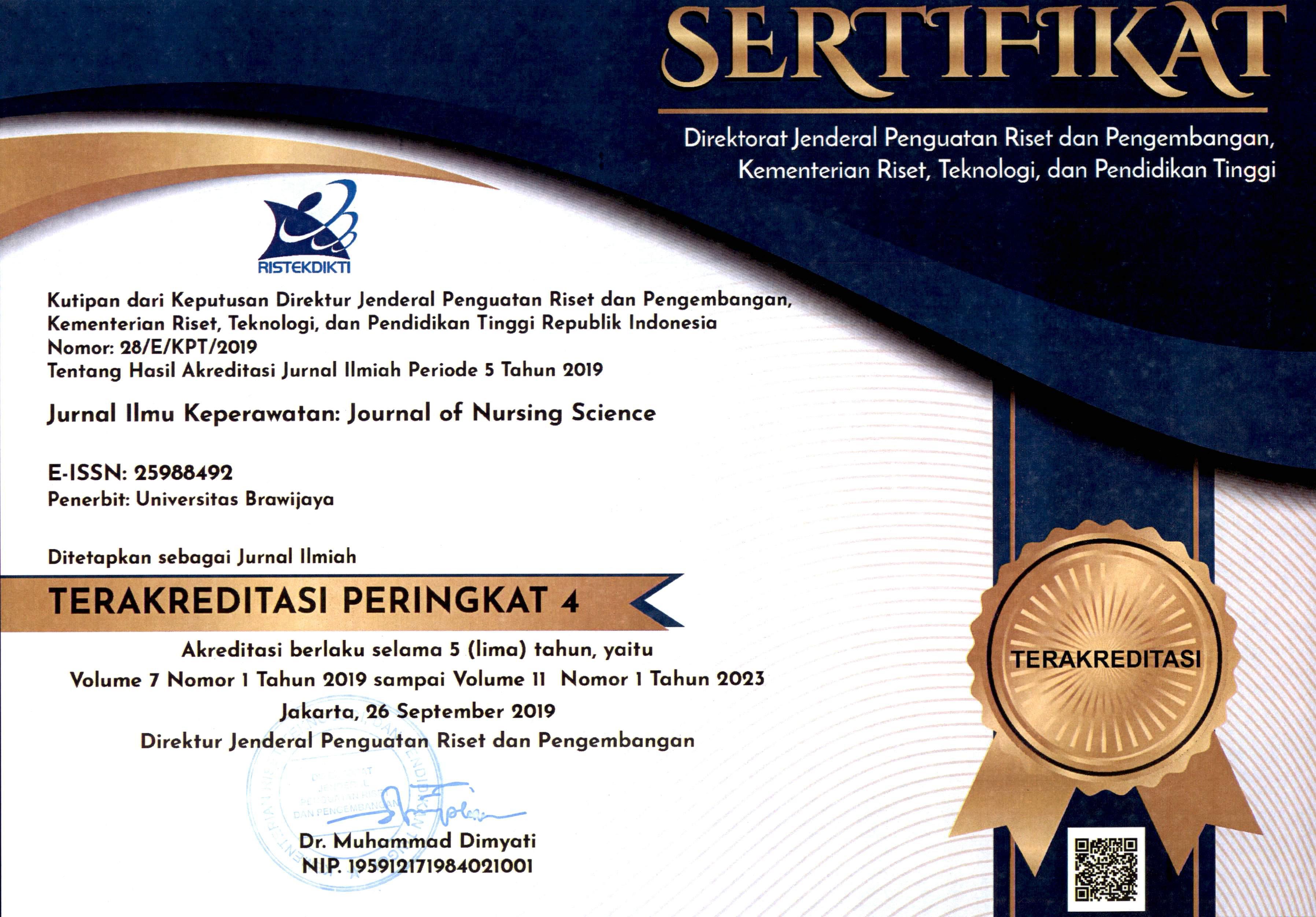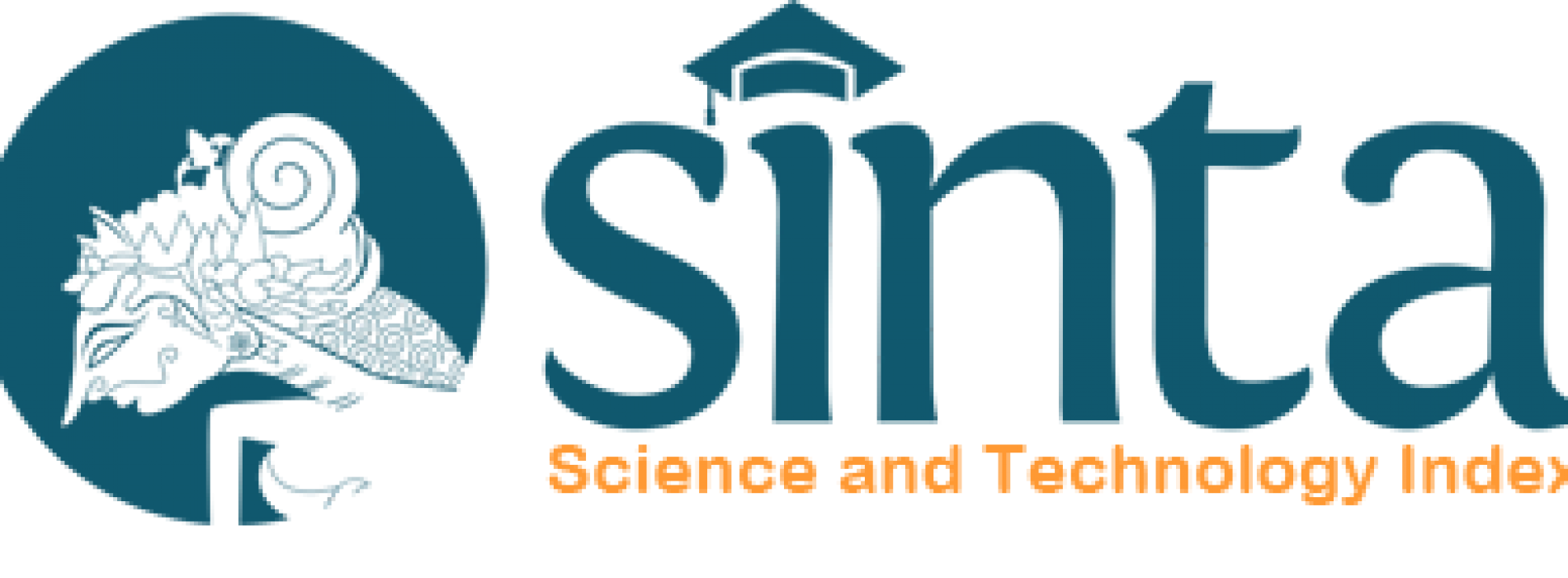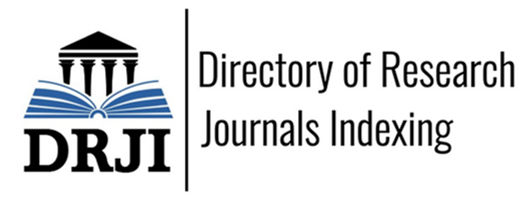FAMILY WITH A CHRONIC ILLNESS: ADAPTATION AND CHALLENGES
DOI:
https://doi.org/10.21776/ub.jik.2017.005.02.1Keywords:
Chronic illness, family challenge, family adaptationAbstract
References
- Allender, J.A., Rector, C., & Warner.K.D. (2010). Community Health Nursing : Promoting and Protecting The Public’s Health. 7th Ed. Philadelphia : Lippincott Williams & Wilkins.
- Branscum, A. (2010). Stress And Coping Model For Family Caregivers Of Older Adults. Tesis . Iowa State University. http://lib.dr.iastate.edu/etd
- Friedman, Bowden & Jones. (2010). Family Nursing : Research, Theory And Parctice.. New Jersey : Prentice Hall.
- Gomes, C,. Boas V, Foss M. (2012). Relationship Among Social Support, Treatment Adherence and Metabolic Control of DM Patient. Rev-Latno Am (Vol 20) (1) : 52-58
- Grant JS, Glandon GI, Elliott TR, Giger JN, Weaver M. (2006). Problems and associated feelings by family caregivers of stroke survivors during the second and third month of caregiving. Top Stroke Rehabil. 2006;13: 66-74
- Haley, W; Jessica Y. A; Joan S. G; Olivio J. C; Martinique P; David L. R. (2009). Problem and Benefits Reported by Stroke Family Caregivers : Results From a Prospective Epidemiological Study. Stroke aha Journals Org. 40: 2129-2133.
- Heniwati, Thabrani, H. (2016). Perbandingan Klaim Penyakit Katastropik Peserta Jaminan Kesehatan Nasional di Provinsi DKI Jakarta dan Nusa Tenggara Timur Tahun 2014. Jurnal Ekonomi Kesehatan Indonesia. Vol 1 No 2 Desember 2016. 88-97.
- Hitchcock, Schubert & Thomas. (1999). Community Health Nursing : Caring In Action. New York : Delmar Publisher.
- Kershaw et al. (2004). Coping Strategies and Quality of Life in Woman With Advanced Breast Cancer and Their Family Caregivers. Psychology Health. 19 : 139-155.
- Knafl, K.A, Gilliss, C,. (2002). Families and Chronicc Illness : A Synthesis of Current Research. Journal Of Family Nursing. 8 (3), 178-198.
- Lim, J., & Zebrack, B. (2004). Caring Family Members With Chronic Physical Illness : A critical Review of Caregiver Literature. Health and Quality of Lifes Outcomes.
- Livneh, H., & Antonak, R. (2005). Psychosocial adaptation to chronic illness and disability: A primer for counselors. Journal of Counseling & Development, 83,12-20.
- Moalosi, G.F., Phatswane, J., Moeti, T., Binkin, N. , Kenyon. T. (2003). Cost-effectiveness of Home Based Care Versus Hospital Care for Chronically Ill Tuberculoasis Patients, Francistown, Botswana. International Journal Tuberculosis Lung Disease 2003 (7) :80-85.
- Mursalin, Soewondo, P. (2016). Analisis Estimasi Biaya Langsung Medis Penderita Diabetes Mellitus Tipe 2 di RSUD Dr. Abdul Aziz Singkawang Tahun 2013. Jurnal Ekonomi Kesehatan Indonesia. Vol 1 No 2 Desember 2016. 71-82.
- Ryan T, Enderby P, Rigby AS. (2006). A randomized controlled trial to evaluate intensity of community-based rehabilitation provision following stroke or hip fracture in old age. Clin Rehabil. 2006;20:123–131.
- Schulz. R., Martire, L.M. (2004). Family Caregiving of Person With Dementia. American Journal Geriatric Psychiatry. 12 (3) : 240-249
- Shimberg, E.F. (1998). Stroke : Petunjuk Penting Bagi Keluarga. Alih Bahasa : Anne Rosana. Jakarta : Pustaka Delapranata.
- Smeltzer, S. C. (2010). Brunner andsuddarth’s textbook of medical-surgical nursing(12th ed). Philadelphia: Lippincott Williams & Wilkins.
- Smith, M., Greenberg, J., & Seltzer, M. (2007). Siblings of adults with schizophrenia: Expectations about future care giving roles. American Journal of Orthopsychiatry (77): 29-37.
- Thompson, J.J. (2009). How Chronic Illness Affects Family Relationship and The Individual. Research Paper. University of Wiscounsin-Stoute.
- Townsend E, Tinson D, Kwan J, Sharpe M. (2006). Fear of recurrence and beliefs about preventing recurrence in persons who have suffered a stroke. J Psychosom Res. 2006;61:747–755.
- Vedhara K Shanks N, Anderson S, Lightman S. (2000). The role of stressors and psychosocial variables in the stress process: A study of chronic caregiver stress. Psychosomatic Medicine 62:374-385.
- Williams LS, Kroenke K, Bakas T, Plue LD, Brizendine E, Tu W, Hendrie H. (2007). Care management of poststroke depression: a randomized, controlled trial. Stroke. 2007;38:998 –1003.
- World Health Organization.(2017). Non-Communicable Disease. Global Health Observatory (GHO) Data. http://www.who.int/gho/ncd/en/ . Diakses pada tanggal 20 Juni 2017
Downloads
Published
How to Cite
License
Authors published in this journal agree to the following terms:
1. The copyright of the received article shall be assigned to the journal as the publisher of the journal. The intended copyright includes the right to publish the article in various forms (including reprints). The journal maintains the publishing rights to the published articles.
2. Authors may enter into separate additional contractual agreements for the non-exclusive distribution of the published journal version of the work (for example, posting it to an institutional repository or publishing it in a book), with acknowledgment of their initial publication in this journal.
3. Authors are permitted and encouraged to post their work online (e.g. in an Institutional Repository or on their website) before and during the submission process, as this can result in a productive exchange, as well as earlier and larger citations of the published work.
4. Articles and all related material published are distributed under Creative Commons Attribution-NonCommercial 4.0 International License or CC BY-NC 4.0 license.
JNSU is licensed under a Creative Commons Attribution-NonCommercial 4.0 International License or CC BY-NC 4.0 license.
Most read articles by the same author(s)
- Annisa Wuri Kartika, Widyatuti Widyatuti, Etty Rekawati, Diabetes Self-Management Education (DSME) Intervention to Improve Self-Care Management of Diabetes Mellitus Patients , Journal of Nursing Science Update (JNSU): Vol. 9 No. 2 (2021)
- Niko Dima Kristianingrum, Wiwin Wiarsih, Astuti Yuni Nursasi, DIABETES SELF-CARE EXPERIENCE ON ELDERLY WITHOUT MEDICATION , Journal of Nursing Science Update (JNSU): Vol. 6 No. 2 (2018)
- Ahsan, Nurul Rahmawati, Annisa Wuri Kartika, The Relationship of Self-Efficacy with Diet Compliance in Type 2 Diabetes Mellitus Patients in Puskesmas Gumawang, OKU Timur Regency , Journal of Nursing Science Update (JNSU): Vol. 10 No. 1 (2022): May





























